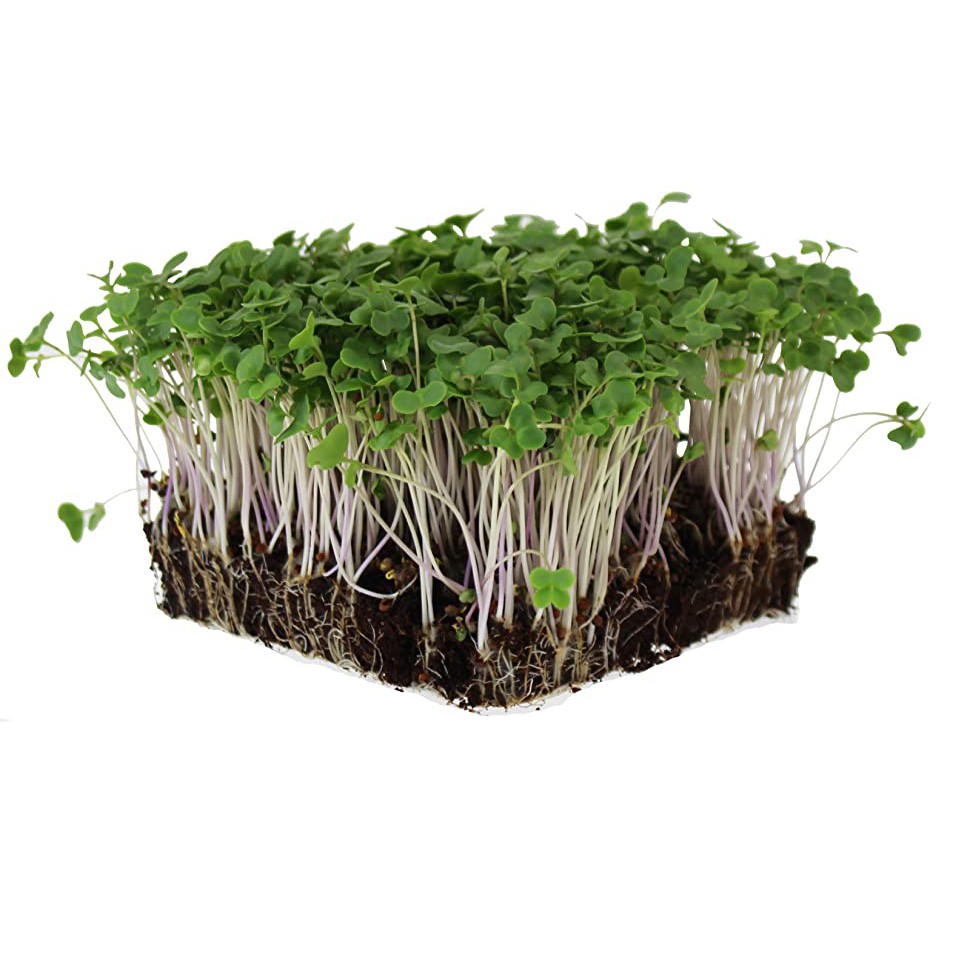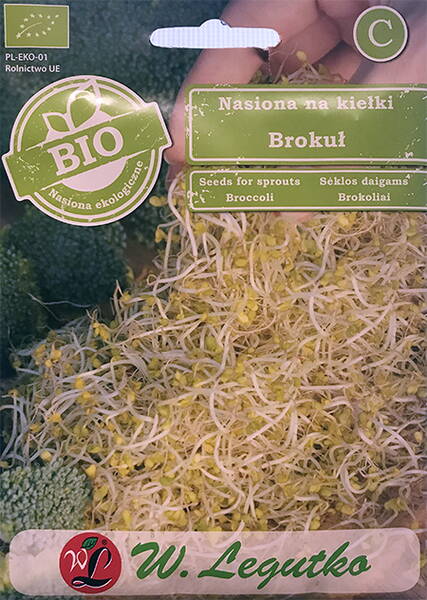Ex Tax: 0.99€
Who would have thought you could grow broccoli as a nutrient-dense mini-plant for two weeks? This amazing microgreen can be one of the healthiest.
Broccoli as a microgreen is an incredible source of protein, and they are just super delicious. You can use this microgreen in most dishes or just as a nice side dish. Broccoli grows very simply and quickly. These sprouts are not only delicious but also rich in nutrients. They contain 40 times more micronutrients than their adult counterpart!
Broccoli belongs to the cabbage family (Brassicaceae, genus Brassica). It comes from Italy and has been considered a valuable food product since Roman times. It was even called "Italian asparagus".
The stems and flower buds are eaten both raw and boiled. Since they are not fully grown, they are softer and more tender compared to the adult version. Broccoli is considered a microgreen when it is 10 to 14 days old in the plant life phase.
Broccoli is a great support for our immune system. It has the same amount of vitamin C as lemons and twice as much as spinach. Broccoli is also rich in vitamin A, which improves eyesight, is good for the skin and supports many of the body's systems in general.
Broccoli microgreens are one of the easiest to grow.
These superfoods start to lose their nutritional value quickly after harvest. The longer the time between harvesting and eating, the less nutrients are retained in vegetables. So enjoy the fresh ones!
You can use broccoli microgreens in a wide variety of dishes.
Eat raw and place it on a sandwich, soup, salads, or just as a pretty decoration.
If you don't want to eat it raw, you can steam it or fry it.
When you cook broccoli over very low heat for only about 5 minutes, all the nutrients will be retained.
* Young sprouts of broccoli cabbage contain a huge amount of ascorbic acid, vitamins B, E, K, A and U, fiber, methionine, zinc, iron, iodine, manganese and other useful substances. Eating broccoli microgreens has a beneficial effect on the health of the eyes, heart and skin, and also helps prevent cancer.

To grow broccoli microgreens at home, you need to decide on a growing method. Although growing broccoli hydroponically is the preferred method, the plants can also be grown in soil. There is no need to soak the seeds, and the tray should be kept covered for the first few days.
Tip: If you sprout broccoli without access to light for the first 4 days, the microgreens will be long and beautiful. These plants are very easy to grow.
The ideal room temperature for sprouting seeds is about +21 °C. The substrate must be kept moist, avoiding it drying out or being too wet. It is recommended to mist the plants 1-2 times a day, especially if the soil is deep, to reduce the frequency of watering. Growing broccoli is not a labor-intensive process, but it is important not to allow the substrate to dry out. When the roots begin to sprout, you will notice thin white threads on them, which should not be confused with mold - these are root hairs. Broccoli microgreens can be harvested as soon as the first pair of true leaves appear on the shoots.
Young broccoli shoots, filled with nutrients, look especially attractive at this time and can be a great addition to almost any dish. Broccoli microgreens contain 5 times more nutrients than a mature plant. The fresher it is, the better the nutrient profile.
The taste of the greens is slightly bitter and is due to the presence of a compound called sulforaphane. This compound is very beneficial for health, as sulforaphane has been found to reduce the risk of cancer. In addition, the presence of sulforaphane lowers blood sugar levels, which can reduce the risk of type II diabetes, as well as reduce the body's ability to store fat. This is why broccoli microgreens are so beneficial for health.
Broccoli greens contain many beneficial substances. For example, broccoli microgreens are rich in vitamin C, which strengthens the immune system and helps fight various diseases. Broccoli greens also contain a lot of vitamin A, which is good for the health of the eyes and bones. Antioxidants contained in broccoli can help prevent the development of cancer and other age-related diseases. In addition, broccoli microgreens improve oxygen absorption, which can help with intense workouts or asthma attacks.
When harvesting broccoli microgreens, you can simply cut off young shoots with a sharp knife or scissors at a level of 2 cm above the ground. It is best to eat them raw after rinsing the greens in cold water. Such microgreens can be added to a salad, put on a sandwich or garnished with soup. Young broccoli shoots are slightly bitter due to the sulforaphane they contain, but this bitterness is rather noble, which makes them a great addition to sandwiches and salads.
Storing greens is an important issue. The best option is to use the greens immediately after trimming. If you haven't treated your plants with chemicals in the last 8-12 hours, you can store them in the refrigerator in an airtight container or plastic bag. If the greens are damp, you can dry them by placing them between two layers of kitchen paper. Microgreens can be stored in the refrigerator for up to 2 weeks if prepared correctly.
The range of crops for obtaining microgreens that can be grown on your windowsill.
In general, all plant crops that are grown and consumed as microgreens are divided into 4 classes:
• Spice-flavoring plants: basil, dill, coriander, parsley, mint, mustard, etc.
• Deciduous and ornamental-deciduous plants: arugula, watercress and other types of salads, red cabbage, broccoli.
• Vegetable crops: peas, mung beans, lentils, beets, chickpeas, radishes, sunflowers, carrots, onions, corn, alfalfa.
• Cereals: buckwheat, oats, wheat.
It is necessary to avoid sprouts of Solanaceae crops. These are: potatoes, tomatoes, bell peppers, eggplants. This is due to the fact that their shoots contain dangerous toxins - solanine and profilins. You cannot sprout beans - dangerous substances are also formed in their young sprouts. The only exception is mung beans - their sprouts are eaten. You probably won't enjoy eating watermelon, melon and cucumber sprouts - they are bitter.
Common crops for growing microgreens: Amaranth, Basil, Borage, Peas, Mustard, Green buckwheat, Daikon, Red cabbage, Savoy cabbage, Kale, Pak choi, Kohlrabi, Mitsuna and Tatsoi, Broccoli, Chervil, Coriander, Garden cress, Corn, Onion, Chives, Leek, Alfalfa, Swiss chard, Carrot, Nasturtium, Parsley, Sunflower, Radishes, Arugula, Beetroot, Celery, Lettuce, Dill, Fennel, Lentils, Sorrel, Spinach.












